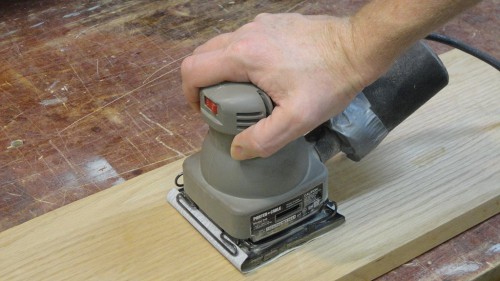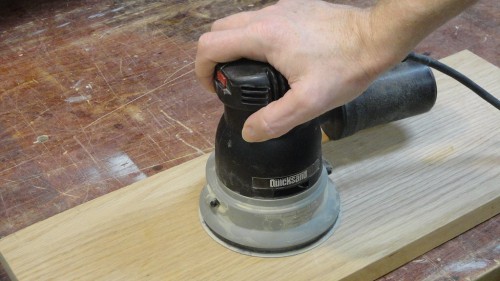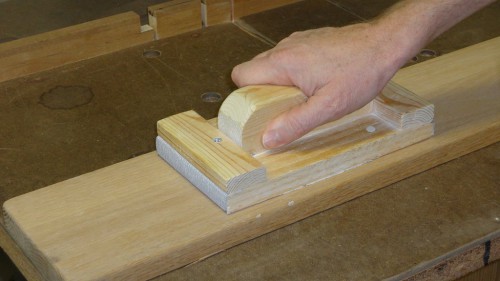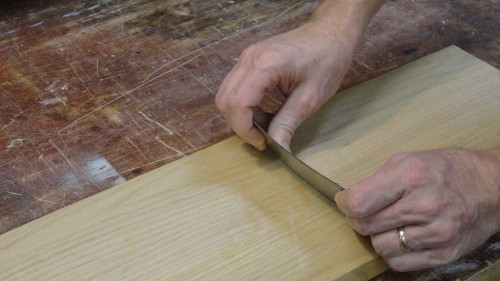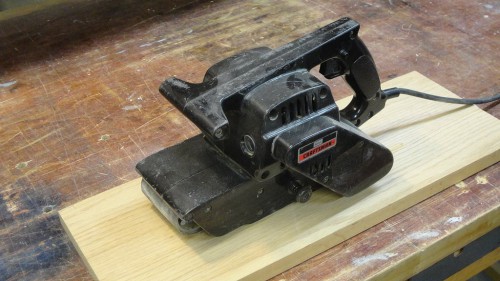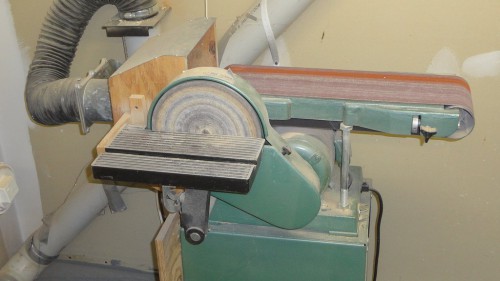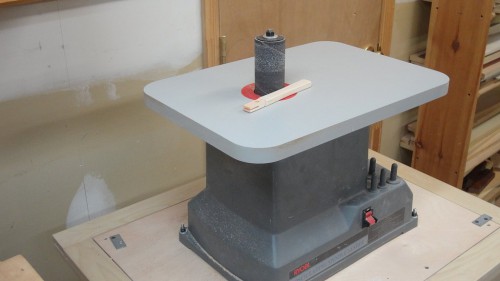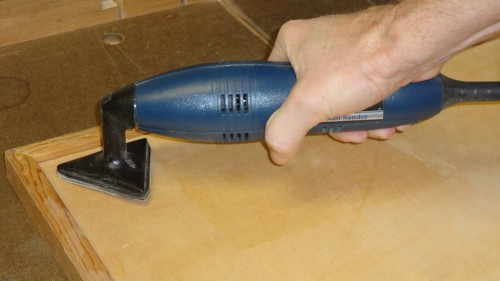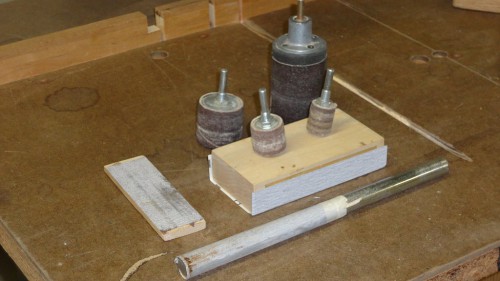I’ve accumulated several different types of sanding tools over the years, some of which are used much more frequently than others but all have their place. My sanding arsenal includes hand-held tools: a sheet sander, a random orbital sander, a belt sander, sanding blocks, a detail sander, and a cabinet scraper, as well as stationary tools: a belt/disk sander combination unit and an oscillating spindle sander. These tools perform varied tasks including rapid material removal, finish sanding, sanding curves, rounding corners, getting into tight spaces, and general purpose smoothing. Here is an overview of these sanding tools along with some usage guidelines.
Sheet Sander
Also called a palm sander, sheet palm sander, or pad sander, the nice thing about these tools is that they use ordinary sanding paper, available at any hardware store – and less expensive than precut sanding disks.Palm sanders use either a 1/3 or 1/4 sheet of sandpaper with 1/4 sheet models being the most common. My Porter Cable sander shown here is a 1/4 sheet sander.
Unlike the random-orbit sander, the sheet sander vibrates the sand paper along the axis of the tool, so it’s important to keep moving and move in the direction of the grain to minimize sanding swirl marks. Even then, they can’t be avoided entirely. A sheet sander does not sand as aggressively as a random orbital sander but I often prefer this slower pace, especially when making a final sanding pass.
Depending on the brand, the sandpaper attaches to the sanding pad with hook and loop fasteners or precut sheets with a peel-and-stick backing. My Porter Cable model uses the hook and loop system. It’s a little bit of a pain to use but seems to work well enough.
Random Orbital Sander
Since it’s introduction in the early 1990’s, the random orbital sander has become a mainstay in the woodshop. This is because it works faster than a vibrating palm sander and it doesn’t leave swirl marks. The latter advantage is a result of the elliptical random orbit of the sanding disk such that the same path is not followed twice. The random sanding action also means that you can sand in any direction, even across the grain, without worrying about leaving sanding marks. Now, that’s nice!
Random orbit sanders use 5″ or 6″ sanding disks that attach using either pressure sensitive adhesives or a hook and loop system. The disks have holes in them that allow sanding dust to be removed during operation. Most sanders, like my Porter Cable, come with a canister to collect the dust or can be hooked up to a vacuum system. I find that the canister works well enough for small sanding tasks but it’s definitely better to hook up the vacuum hose for the bigger jobs.
Sanding Blocks
Yes, there’s still a place for the old fashioned sanding block. The one shown here can accommodate a 1/2 sheet of sandpaper and is designed for sanding flat surfaces. The ends of the paper are attached by two wooden cleats that screw down against the base to hold the paper in place. The handle is simply a small block cut out from a section of 2″ x 4″ with the ends rounded. If you’re really into hand sanding, you might consider buying a palm-friendly rubber sanding block; most of these are designed for a 1/4 sheet of sandpaper.
A sanding block works much better than hand sanding without a block because in the latter situation, there’s a tendency to create an uneven surface due to differences in finger pressure. It doesn’t take a lot of skill to use a sanding block — just a bit of elbow grease and the right type of sandpaper. Since sanding blocks are commonly used for final sanding passes, this means fine grit paper, say 180-220 grit. In terms of abrasives, I typically use garnet or silicon carbide sand paper for hand sanding.
Cabinet Scraper
A cabinet scraper may not be a sanding tool per se but it fulfills the same purpose as one. In fact, it often does the job quicker and better. A scraped wood surface it typically smoother and shinier than a sanded surface. Some might even say more natural. A properly sharpened cabinet scraper is a satisfying tool to use. Wood scrapings seems to magically appear as the surface blemishes disappear and there’s no annoying electrical motor sounds. Just man and metal versus wood.
The trick to effective scraping is to form a small burr on the edge of the scraper using a burnishing tool such as an old chisel. The scraper is then held at a low angle to the wood and pulled over the surface so that the hook of the burr engages the wood, forming shavings on the edge of the scraper against the wood. There’s also a technique for forming the burr using a stationary belt sander but that’s a bit unorthodox (which isn’t to say I haven’t used the technique more than once…)
Belt Sander
When you need to remove material quickly, nothing beats a belt sander. These beasts sand very aggressively making them a good choice for the initial sanding pass over roughly planed wood, for removing paints and finishes, or for rapidly removing excess wood such as edging strips that projects above the mating wood surface. If you’re careful, you can even fit a belt sander with fine grit sand paper to create a smooth and level surface.
I have an old Sears Craftsman belt sander that’s still going strong after 25+ years. Because I typically use it for rapid removal tasks, I seldom go finer than 100 grit. In fact, 60 to 80 grit is usually what I use. It gets the most use for sanding edging strips, leveling glued up panels, and sharpening the blades for my lawn mower.
When sanding with a hand-held belt sander, it’s often faster to sand at an angle to the grain rather than parallel to the grain. Yes, this will leave lots of sanding marks but these can be removed in subsequent sanding passes using less aggressive sanding tools.
A few words of caution: It is important to keep the sander moving. If it stays in one spot for more than a few seconds, it will leave a pronounced sanding depression or even a gouge in the wood. Be especially careful when sanding near the edges of a board because there is a tendency to oversand the edges more than the middle.
Stationary Belt and Disk Sander
A stationary belt/disk sander combination unit is faster than using hand-held sanding tools for certain tasks. A good example is flattening a small board, a task that can be dangerous using a jointer or tricky with a hand-held sander because of the tendency to round the corners. With a stationary belt sander, this job is a relative breeze (just make sure you don’t sand your fingertips!)
Other uses of a belt/disk sander are quickly rounding corners, smoothing a rough cut, bevel sanding, and shaping small pieces. In general, a stationary sander works well for items that are easier to hold and manipulate with your hands versus trying to clamp them to a table and sand using a hand-held tool.
Dust collection is important with a stationary belt/disk sander because these babies produce lots of dust. I had to fashion a dust collection port for my old brand X model since it didn’t have built-in dust collection — it’s crude but effective.
Oscillating Spindle Sander
If you’ve ever tried to sand a curved surface using drum sanders mounted on a drill press or a hand-held drill, you’ll really appreciate an oscillating spindle sander. This is a stationary table sander with a spindle that moves up and down, greatly enhancing the sanding efficiency and minimizing scratches, compared to a non-oscillating drum sander.
A spindle sander may not see as much action as other types of sanding tools, but it’s the tool to have when it comes to sanding convex or concave curves and smoothing out holes. It accommodates curves of varying diameters by mounting rubber drums of different diameters onto a metal spindle and then sliding a cylindrical sandpaper sleeve onto the drum. The sleeve is held in place by tightening a nut on the shaft which compresses the drum, forcing it to expand slightly in diameter enough to secure the sanding sleeve in position.
I have a Ryobi oscillating spindle sander and find it adequate for the miscellaneous irregular surface sanding jobs that crop up. It is mounted on a flip-top table so I can quickly set it up for the occasional use and then flip it back down out of the way the rest of the time.
Detail Sander
In the niche tool department, we have detail sanders, also known as triangular sanders. These are small hand-held sanders with a triangular-shaped head that is designed for sanding nooks, corners, and other tight spaces. They work especially well for sanding off finish in hard-to-reach areas; if you have a refinishing project involving shutters, doors, or windows, a detail sander may be just the ticket.
As far as sanding bare wood, I find that my Ryobi detail sander leaves small cross-grain scratches that match the arc of the vibrating head. I’ve heard the same said of other brands of detail sanders. So, this may not be the Holy Grail for sanding a freshly built piece of furniture. On the other hand, if there’s a deep scratch in a hard-to-reach corner, small sanding scratches left over from sanding out the blemish with a detail sander seems like a reasonable compromise.
Details sanders come in corded and cordless models and often come with multiple attachments. The Fein Multimaster detail sander, for example, comes with saw blade and shaper attachments.
Miscellaneous Sanding Tools
My sanding tools collection includes several custom-made sanding blocks to handle items of varying sizes. These are made by cutting a piece of wood to the desired size and then attaching sand paper via double-sided tape. I also have a jig for sanding holes and tight curves. This is essentially a piece of sandpaper taped to a metal rod. It is mostly used for detail sanding or take the sharp edges off a cut-out hole. For more aggressive curved sanding, I have an assortment of sanding drums that are attached to the drill press or a hand drill. However, since I purchased an oscillating spindle sander, I seldom use the sanding drums anymore.


